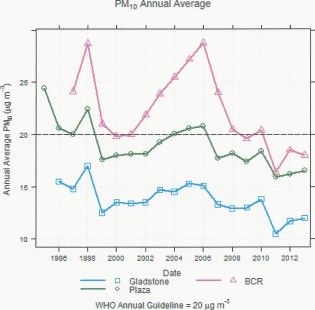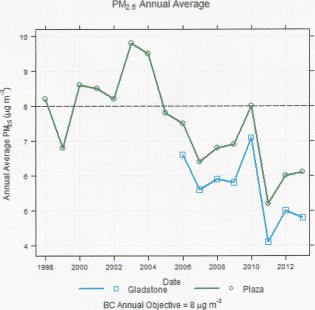Air Quality Trend Promising
Prince George, B.C. – There is encouraging news on the air quality in Prince George.
The latest report from the Provincial Ministry of the Environment shows there is a distinct downward trend in annual levels of fine particulates. with most annual averages since the mid 90’s being below the Provincial targets.
While the decline in fine particulates started with the end of beehive burners, there has been a great deal of work done by industry and PGAIR to manage sources of fine particulates. reductions in open burning, use of coarser materials for winter traction, and improved street cleaning, have all contributed to the improvements in air quality.
The graph above and at right, show a spike in fine particulate, that spike happened in 2010 and was the result of active wildfires. A similar spike can be expected this year, as Prince George found itself under a blanket of wildfire smoke several days over the summer.
The annual report also shows a significant decrease in the number of times the provincial targets for fine particulates have been exceeded.
For PM 10, there were 35 days in 1995 when the 24 hour average was above the provincial target, that had reduced to 8 in 2013.
For PM 2.5, there were 25 days in 2004 which saw the 24 hour rolling average exceed the provincial target, and only four such instances in 2013.
“We are never going to have an airshed where there aren’t some levels of fine particulate” says Terry Robert “There will always be things that are beyond our control, such as wildfires, but we can do what we can to reduce the industrial sources and the human sources to reduce the number of times the air quality exceeds the provincial standards.”



Comments
I wonder how much impact the Canfor Low Odour upgrade at Northwood had.
That is great news.
But don’t forget to factor in the following facts.
How many mills have closed since 1995.
That were located out in the BCR site.
Which also reduces the number of logging & chip trucks.
Along with the number of employees and services travelling.
Always lots of talk about wild fires, wood burning stoves, street cleaning in the spring etc….but you don’t hear about industry, that is ever constant in spring summer fall and winter, and you can bet, when it smells, there are particulates.
That wasn’t at Northwood that was at Intercon
spike happened in 2010 and was the result of active wildfires.
===============================================================
Doubt very much that forest fires produce a lot of 2.5 particulate. Most of it comes from industry and diesel fuel emissions. And then there is the BCR Industrial site. Its another story.
Cheers
Project was primarily from 2010 to 2011 and cost $130 million which $100M was GTP federal government money. It was at NW, I worked on it.
Comments for this article are closed.